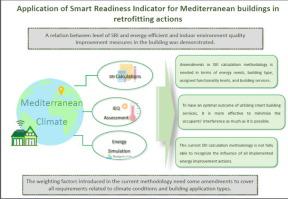Energy and Buildings ( IF 6.6 ) Pub Date : 2021-06-10 , DOI: 10.1016/j.enbuild.2021.111173 Bahareh Ramezani , Manuel. Gameiro da Silva , Nuno Simões

|
Recent years have seen an increasing need to invest in smart, energy-efficient technologies in buildings to improve health and convenience for occupants and to reduce energy consumption and carbon emission impacts. Digitalization and developments in the information and communication technology sector play a critical role in improving the efficiency of the European energy market and remaining in the current progress of sustainable and renewable energy systems. Therefore, the European Union Member States are required to establish an optional common scheme for defining and calculating a descriptor, called a smart readiness indicator to assess the capabilities of buildings to adapt their operation to the needs of the occupants and the electricity grid and to achieve more efficient operation.
This indicator is calculated using a methodology proposed and developed by the European Commission Directorate-General for Energy which depends to a great extent on various factors such as building type and climate conditions. The effectiveness of these parameters on the Smart Readiness Indicator is reflected by the weighting coefficients which need to be initially defined by the legislator. Therefore, the main step to assess the viability of this methodology, is to test it in different situations, i.e., various building types, climate conditions, etc. To this end, the proposed methodology is applied in two service buildings with different levels of energy and indoor environment quality performance located in an area with a Mediterranean climate. The possible effects of smart services and retrofit actions on indoor environment quality and energy performance in the buildings were assessed through energy simulation for two separate rooms in the buildings, a monitoring campaign and a survey to assess the occupants’ subjective opinion about the indoor environmental quality using the questionnaire proposed by the Centre for the Built Environment of the University of California.
The results imply that, although the proposed methodology was able to recognise the overall characteristics of the sample buildings, some amendments are still required to capture the specific features of non-residential Mediterranean climate buildings. More specifically, the defined weighting factors fail to reflect the actual energy performance of the service buildings and need to be revised. Moreover, the current retrofitting actions which were implemented to improve energy efficiency and thermal comfort in the building were not as effective as expected in enhancing the SRI value.
中文翻译:

地中海建筑智能就绪指示器在改造行动中的应用
近年来,越来越需要投资于建筑中的智能、节能技术,以改善居住者的健康和便利,并减少能源消耗和碳排放影响。信息和通信技术领域的数字化和发展在提高欧洲能源市场的效率和保持可持续和可再生能源系统的当前进展方面发挥着关键作用。因此,欧盟成员国需要建立一个可选的通用方案来定义和计算一个描述符,称为智能就绪指标,以评估建筑物的能力,使其运行适应居住者和电网的需求,并实现更高效的运作。
该指标是使用欧洲委员会能源总局提议和开发的方法计算的,该方法在很大程度上取决于各种因素,例如建筑类型和气候条件。这些参数对智能就绪指标的有效性通过需要由立法者最初定义的加权系数反映出来。因此,评估该方法的可行性的主要步骤是在不同情况下对其进行测试,即各种建筑类型、气候条件等。为此,所提出的方法应用于具有不同能源水平的两个服务建筑和位于地中海气候地区的室内环境质量表现。
结果表明,虽然所提出的方法能够识别样本建筑的整体特征,但仍需要进行一些修改以捕捉非住宅地中海气候建筑的特定特征。更具体地说,定义的权重系数不能反映服务建筑的实际能源性能,需要修改。此外,目前为提高建筑物的能源效率和热舒适性而实施的改造措施在提高 SRI 值方面并不如预期那样有效。











































 京公网安备 11010802027423号
京公网安备 11010802027423号